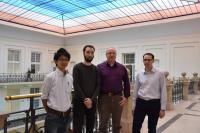Super-calculations of the WUT Physicists on a Supercomputer
For the first time in history, a Polish research team will work with the largest European supercomputer – Piz Daint. The research group led by Gabriel Wlazłowski, PhD (Eng.) from the Faculty of Physics at the WUT will explore the secrets of superfluidity and superconductivity. Are they preparing a ground-breaking discovery?
“We are trying to create a method that would very precisely describe behaviours of superfluid and superconducting systems,” explains Gabriel Wlazłowski, PhD (Eng.). “For many years, we have known these equations. The problem lies in their solutions – they are very complicated; therefore, we need a supercomputer to solve them.”
Magic Materials
In early 20th century, the Dutch physicist Heike Kamerlingh-Onnes discovered that there are materials whose electric resistance disappears completely. He called them superconductors, and the phenomenon itself – superconductivity. It can be achieved with certain materials, generally in a very low temperature. On the other hand, superfluidity is a material phase characterized by a complete lack of viscosity. What does it mean? More or less, that matter in this state – if set in motion in any closed system – can move endlessly without requiring any additional energy.
“It is like this: we have particles of a system that can move without friction,” explains Gabriel Wlazłowski, PhD (Eng.). “If these particles have an electric charge, such electric current flows without resistance, and we are talking about superconductivity. However, we can have such parts of this system that do not have a charge, e.g. atoms, and then we are talking about superfluidity.”
Scientists have been interested in these phenomena for years. Physicists have received several Nobel prizes for subsequent discoveries in this regard. Superconductors – due to their specific properties – are very important in technology and science. They can endlessly sustain particle motion without losses. Electric current – once excited – flows even after disconnecting the external source.
A New Look
The purpose of the scientific research conducted by the team of Gabriel Wlazłowski, PhD (Eng.) will be to check how precisely modern science can predict the behaviour of superconductors and superfluids. It turns out that both types of systems can be described using a single coherent theory – quantum mechanics.
Even though mathematical equations describing superconductivity and superfluidity have been known for 60 years, their complete solution is still a great challenge for science. Only supercomputers equipped with hundreds of thousands of processors and tens of thousands of gigabytes of RAM can handle this challenge. “Up to this point, the main barrier in solving these equations were insufficient computational units,” says Dr Wlazłowski. “Naturally, they tried to solve these equations, but they used certain approximations and simplifications, which did not translate to a complete image of studied phenomena.”
Scientists from the Faculty of Physics at the Warsaw University of Technology have been developing appropriate software for studying these phenomena for over 10 years. During this time, they have been authorized several times to access other supercomputers, even better than Piz Daint in Switzerland. “Many years of hard work provided us with research tools that no one else has,” says Prof. Piotr Magierski, PhD (Eng.). “At this moment, we are the absolute leaders worldwide.”
Super-calculations on a Supercomputer
Dr Wlazłowski’s international team will work with the supercomputer Piz Daint for a year: scientists and supercomputing experts from the Warsaw University of Technology (Prof. Piotr Magierski, Dr Janusz Oleniacz, Dr Kazuyuki Sekizawa, Dr Janina Grineviciute, Bugra Tuzemen, MSc, and Konrad Kobuszewski, Eng.), and from the Interdisciplinary Centre for Modelling at the University of Warsaw (Maciej Marchwiany, MSc). The team is further complemented by scientists from the United States: Prof. Aurel Bulgac and Shi Jin, MSc from the Washington State University, Dr Ionel Stetcu from the Los Alamos National Laboratory, and Dr Kenneth Roche from the Pacific Northwest National Laboratory.
The work will take place remotely. Its complexity lies in the fact that the team operates on several levels. “The basic issue is – of course – knowledge of physical processes,” lists Prof. Piotr Magierski. “The second level covers translating physical phenomena to a language understood by the computer. Finally, we need to remember and adjust computational methods to the architecture of that computer.”
Will There Be a Revolution?
“The phenomenon of superfluidity is very important in the process of nuclear fission, and additional knowledge about this topic can help us better manage nuclear energy and increase reactor efficiency,” explains Prof. Magierski. “However, we are searching for new phenomena that haven’t been yet noticed or researched.”
“We are looking quite widely at the phenomena of superconductivity and superfluidity”, adds Dr Wlazłowski. “We study atomic nuclei, which are both superfluids and superconductors. Stars can also be superfluids. We wish to describe all these phenomena with one consistent theory.”
It is no wonder then that our scientists impatiently await the results of their research. “We hope that we will be able to predict something interesting,” says Prof. Piotr Magierski. “We know that no one can overtake us now.”
---------------------------------------------
Our scientists have received a computational grant as part of the competition announced by PRACE (Partnership for Advanced Computing in Europe). The purpose of this European institution from Brussels is to provide access to the largest supercomputers for the most innovative European research projects.
The research will be funded by the National Science Centre, as part of the MAESTRO grant of Prof. Piotr Magierski, and the SONATA grant of Dr Gabriel Wlazłowski.
Monika Bukowska
Office for Promotion and Information









